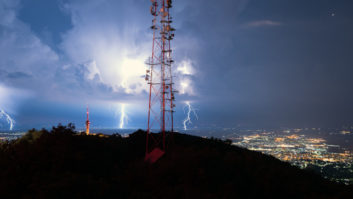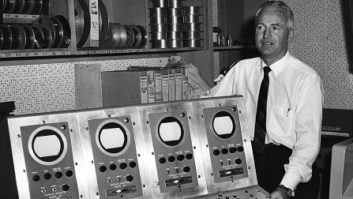You’ve heard talk from pundits (like me) who say that if managers want their radio businesses to prosper, they should think of themselves as content providers rather than broadcasters.
A company that walks the talk is Delmarva Broadcasting, owner of 11 Delaware and Maryland radio stations plus one Web-only outlet; its licenses include flagship WDEL(AM) in Wilmington. That’s where I landed my first full-time job in radio; but I’m writing about the company today because it is exploring its own limits once again.
In the quarter century since I encountered Delmarva Broadcasting and probably longer, the company has innovated, in technology as well as programming, sales and localism strategies. It was an early adopter of touchscreen automation. It explored RDS-controlled billboards and AM stereo. It expanded its local news staff at a time when many AM outlets were doing the opposite. It computerized its newsroom early, built a successful in-house traffic service and has managed a program of consistent, long-term capital plant improvement.
As I write, its engineers are setting up the company’s first multicasting channel on WSTW(FM), which switched on HD Radio in December.
But even with that history, WDEL’s newsroom staff must have raised their eyebrows when management recently handed them video cameras to replace their familiar portable audio recorders. I know I did when I read about it in an NAB convention preview story on page 20 of this issue.
Local
“Delaware does not have its own VHF/UHF stations. There is no real local TV news.”
Corporate Operations Manager Bob Mercer is explaining to me the reasoning behind the company’s newest product: WDEL Video News, an online newscast that is posted at 8 a.m. each day and also is available as a series of separate video story clips.
The service is also something of a step back in time, because WDEL(TV) served the market until the late 1950s. “Now the Web opens that opportunity up again – to extend our antenna, if you will. It’s the MBA ‘economy of scale’ kind of thing. We’ve extended our product from on-air news, to on-the-Web written, to on-the-Web audio cuts, and now to video.”
The project was the brainchild of Mercer and Delmarva President/CEO Pete Booker.
“We’ve had this vision for going on five years,” Mercer said. “This year WDEL and WSTW are celebrating 10 years on the Internet, so we were early adopters. … We’ve seen potential for our product being extended, through the Web and the many other devices out there that are using network connections.”
The daily video news roundup serves a savvy audience that is accustomed to watching news from big-market television stations out of nearby Philadelphia but hungers for more Delaware-specific content. The program is produced by the WDEL news department, using video collected in the field by radio news staffers in the course of their work. The station has six full-time news staff, and eight to 10 part-timers.
“Since WDEL was a local source of news for all these years, this was a logical extension,” Mercer said. “We were able to come up with a scheme that lets our local reporters use a video camera to record local events. The camera records digital audio as well.”
Delmarva equipped the news staff with off-the-shelf, high-quality Canon consumer cameras, and installed “prosumer” videocams, a Chroma Key screen and a lighting rig in one of its production rooms. An employee with cable TV experience has the full-time job of editing and producing the newscast and running the cameras.
The field cameras capture sound for use in the WDEL radio newscasts; reporters can literally “keep the cap on,” recording only audio if they want. “But we’ve taught them to do some very basic ‘essence of the story’ shots, B roll stuff. It doesn’t add a great deal of time (although some of them might argue with me about that) to the process of getting the local story,” Mercer said.
Back in the newsroom, he figures, the video work adds 10 to 20 minutes to the time to edit an average story. “They come back with short clips. It’s very easy to roll off, do quick edits and put a package together.”
The packages are compiled into an early-morning newscast so that WDEL listeners can become WDEL viewers. Content is available in three Windows Media Player versions, with varying resolutions, plus an MPEG-4 version for viewing with Apple QuickTime or on a video iPod.
“Since we went up with MPEG-4, we saw an immediate jump in the viewing of the ‘Video News,’ just in the past three weeks,” Mercer said. (You can watch the program at www.wdel.com )
Pick and choose
The initial capital cost was about $60,000. Additional expenses are bandwidth and salary for the production person. Delmarva’s engineering staff was called on to run network cables for the video production package and computer, and to create customized mic cables for the camera rigs.
The video service was launched last summer and Mercer says it is growing, slowly.
“People aren’t calling up and saying, ‘We love your video news.’ We tell by measuring the number of visits.” Because visitors can also view stories “a la carte,” often a story will receive hundreds of views. The overall daily package has fewer viewers, but each month, he says, the number grows.
A locally produced video news product, Mercer knows, isn’t for every radio outlet.
“Frankly I’m not sure this is a model that would work in a major market, where you have a lot of TV stations,” he said. But in a city like Wilmington, where the TV news competition is from outside the immediate area, or for stations in outlying areas, he feels video news can work.
If a radio station doesn’t wish to produce a full newscast or can’t afford it, it might try posting just individual video stories.
Delmarva is considering consulting, to explain for a fee how it brought these elements together without overwhelming a radio news department. The station managers will have their ears open for interest during the upcoming NAB convention.
“No other radio broadcasters I know of are doing this,” Mercer said. The closest thing he’s seen is video offered by a radio station that has a sister TV operation. “We’ve only seen one or two that even came close.”
I wondered about the workflow implications and whether the staff resisted. “Some days the reporters get frustrated,” Mercer said, and there was some initial resistance, mostly out of trepidation of something unknown. That largely has passed, he said.
“For the most part there’s a pride in their workmanship. You look at it and (realize) it’s a complete professional package.”
To me, a former radio news guy with a bit of TV news experience, the project is intriguing. I know this: If I were toting a camera in place of an audio recorder, it would change the way I did my job. A camera is a different beast than a microphone; the person on the other end of it will have a different response to it.
I also can imagine issues from a management strategy standpoint. If your station requires that its radio newspeople become videographers, do you pay them as such? Do you spend money to train them in video skills? Are you willing to spend the big bucks that quality video production can cost? Might a station risk hurting its hard-earned brand image by putting out inferior video?
These questions are going to be answered by individual circumstances. But I commend Delmarva for the idea, for not simply lamenting that radio has become such a tough business but instead finding opportunities in new channels and then spending money to explore them. Oh – and of course, this is relatively inexpensive content that can attract new ad money.
From Mercer’s perspective, the video project is worthwhile.
“Everything about it, I love. Sure, there’s always learning curves and little bumps, production equipment failures, but we expected that. We worked our way through that kind of stuff.”
For a station in a market with a similar set of circumstances, he said, video news can make sense as a natural extension of its product.
“People,” said radio veteran Bob Mercer, “tend to think in pictures.”












